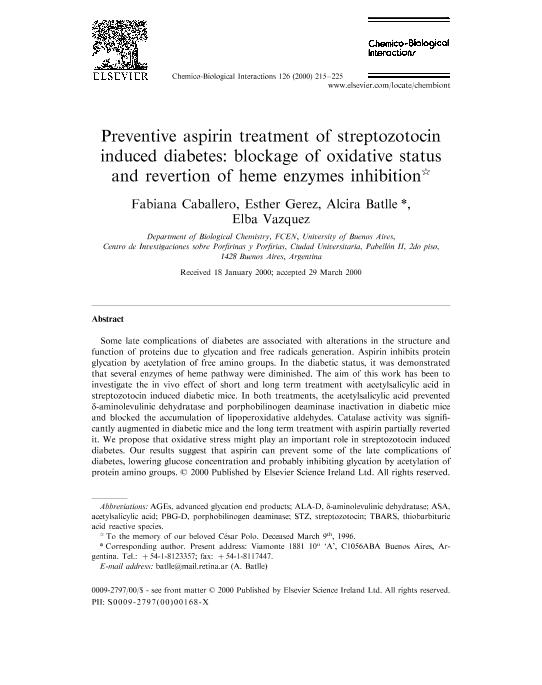Artículo
Preventive aspirin treatment of streptozotocin induced diabetes: Blockage of oxidative status and revertion of heme enzymes inhibition
Caballero, Fabiana Alejandra ; Gerez, Esther Noemi
; Gerez, Esther Noemi ; Batlle, Alcira María del C.
; Batlle, Alcira María del C. ; Vazquez, Elba Susana
; Vazquez, Elba Susana
 ; Gerez, Esther Noemi
; Gerez, Esther Noemi ; Batlle, Alcira María del C.
; Batlle, Alcira María del C. ; Vazquez, Elba Susana
; Vazquez, Elba Susana
Fecha de publicación:
06/2000
Editorial:
Elsevier Ireland
Revista:
Chemico-biological Interactions
ISSN:
0009-2797
Idioma:
Inglés
Tipo de recurso:
Artículo publicado
Clasificación temática:
Resumen
Some late complications of diabetes are associated with alterations in the structure and function of proteins due to glycation and free radicals generation. Aspirin inhibits protein glycation by acetylation of free amino groups. In the diabetic status, it was demonstrated that several enzymes of heme pathway were diminished. The aim of this work has been to investigate the in vivo effect of short and long term treatment with acetylsalicylic acid in streptozotocin induced diabetic mice. In both treatments, the acetylsalicylic acid prevented δ-aminolevulinic dehydratase and porphobilinogen deaminase inactivation in diabetic mice and blocked the accumulation of lipoperoxidative aldehydes. Catalase activity was significantly augmented in diabetic mice and the long term treatment with aspirin partially reverted it. We propose that oxidative stress might play an important role in streptozotocin induced diabetes. Our results suggest that aspirin can prevent some of the late complications of diabetes, lowering glucose concentration and probably inhibiting glycation by acetylation of protein amino groups. Copyright (C) 2000 Elsevier Science Ireland Ltd.
Archivos asociados
Licencia
Identificadores
Colecciones
Articulos(CIPYP)
Articulos de CENTRO DE INVEST. SOBRE PORFIRINAS Y PORFIRIAS
Articulos de CENTRO DE INVEST. SOBRE PORFIRINAS Y PORFIRIAS
Citación
Caballero, Fabiana Alejandra; Gerez, Esther Noemi; Batlle, Alcira María del C.; Vazquez, Elba Susana; Preventive aspirin treatment of streptozotocin induced diabetes: Blockage of oxidative status and revertion of heme enzymes inhibition; Elsevier Ireland; Chemico-biological Interactions; 126; 3; 6-2000; 215-225
Compartir
Altmétricas



